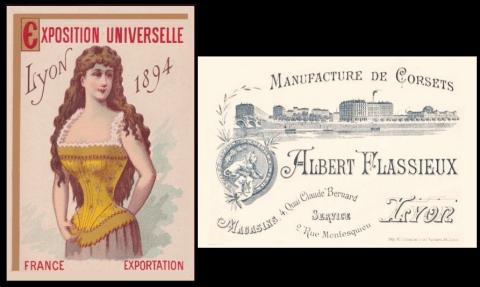
Underwear stayed almost the same until Victorian times, when the corset was re-invented - contorting and conforming the female body into a man`s ideal, and a shape it was never designed to make. It was not a new idea, and it appears that the Minoans used to wear them, both men and women, but we are not entirely sure why, though we think it was for ceremonial purposes rather than everyday wear.
As civilisation changed, and Europe became ruled ever more by the Church, the corset fell foul of censorship, for it enhanced the human body in every way. It was not until the sixteenth century, and only then in Italy, that a kind of corset returned to the clothing of the upper classes. It moved quickly into France and then to England, and it was soon intimately connected with the whaling industry, which supplied their surplus of bone in order to make the supporting framework. Sailors would also turn their hand to carving scenes on a particularly long piece of bone which would slide down the front to increase its rigidity.
The constriction really took off in the eighteenth century, when the corset started to be cut to an ever sharper shape and the lacing was developed so that it could be pulled tighter, once on the body, than it could ever be made. That pushed the ribs and stomach in so that the hips were enlarged. We are not sure why this was - though some social historians think it was to make it look like the women had larger hips than anywhere else and could therefore bear children more easily. However pushing the stomach in to such a degree actually had serious effects on the reproductive system.
The Victorian corset took this to the extreme, squeezing the female form so that the bust and hips were enhanced and the waist was like an hourglass centre in between. You can see this on our card, and how unnatural it looks.
This may have continued, if not for the First World War. When the women took over the jobs that men had been doing, most of which were strenuous, and involved lifting and stretching, there was no way that they could do that and wear a corset, so they abandoned them. And liked it. And after the war there were few women who wanted to put them on again.
They did make a comeback when movies started to feature stars with curvy shapes, in the late 1930s, but soon disappeared with the coming of the Second World War.
However, in recent times they have started to make a come back, thanks to popular culture, with movies, music, drag, burlesque, and the adult entertaiment industry all making lingerie acceptable as outer wear. Some say Madonna started it all, with the pink corset she wore on her "Blond Ambition" Tour of 1990 - but there were many before her, including the 1950s icon Bettie Page.
This card seems to have been given away at the Paris Exhibition, or, to give it its correct title "L`Exposition Universelle, Internationale et Coloniale" (or The World`s Fair, International and Colonial". It was held in Lyon, France, between the 29th of April and the 11th of November 1894. And today it is most famous not for bringing the nations together, but for the assassination of the French President, Marie Francois Sadi Carnot, on the 24th of June.
As for Albert Flassieux, I cannot find him, only that he is cited in the medallion table of the official guide - and you can see that, in its entirety, as a PDF in the Lyon Museum. He appears on page 6, under class XX, Articles de bonneterie et lingerie, (Hosiery and Corsetry), as having won a diploma with an honorable mention - as "Flassieux, 4, Quai Claude Bernard, Lyon", and that is the address on this card.
